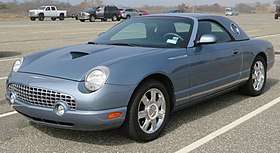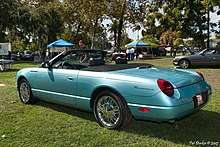Ford Thunderbird (eleventh generation)
The eleventh generation of the Ford Thunderbird is a two-passenger, front-engine/rear-drive grand touring convertible manufactured and marketed by Ford for model years 2002-2005, sharing the Ford DEW platform and styled to strongly recall the first generation 1955 Thunderbird, including its removable hardtop with prominent circular glazing, [1] with a power folding top that could lower in ten seconds and a vinyl tonneau cover.[2]
| Ford Thunderbird Eleventh Generation | |
|---|---|
 | |
| Overview | |
| Manufacturer | Ford Motor Company |
| Production | June 5, 2001—July 1, 2005 |
| Model years | 2002–2005 |
| Assembly | Wixom Assembly |
| Designer | Jack Telnack (1997) |
| Body and chassis | |
| Class | Personal luxury car |
| Body style | 2-door convertible (with optional hardtop) |
| Layout | Front-engine, rear-wheel drive |
| Platform | Ford DEW98 |
| Related |
|
| Powertrain | |
| Engine | 3.9 L Jaguar AJ35 V8 |
| Transmission | 5-speed Ford Bordeaux 5R44E automatic |
| Dimensions | |
| Wheelbase | 107.2 in (2,723 mm) |
| Length | 186.3 in (4,732 mm) |
| Width | 72 in (1,829 mm) |
| Height | 52.1 in (1,323 mm) |
| Chronology | |
| Predecessor | Ford Thunderbird (tenth generation) |
Ford introduced a concept prototype for this Thunderbird at the 1999 North American International Auto Show[3] on January 3, 1999,[1] 45 years after the debut of the original.[1] Production models arrived in mid-2001 for model year 2002, more than two years after the concept.[4]
Foregoing an emphasis on sports performance or dynamic balance, the design featured a competitively powered V8 engine with weight and suspension favoring comfort and grand touring.
Design


According to Jack Telnack, Ford;s Vice President of Design (1980-1997), the Thunderbird design gestation was the longest of his career and was largely finalized before he retired from Ford in 1997. His successor, J Mays resolved "details, trim, fabric, the interior design and colors"[5] and presenting the 2002 production model in 1999.[5]
For the design, Telnack enlisted competing studios in Italy, England, Germany, California and Dearborn, bringing a 1955 and a 1957 Thunderbird to the Dearborn studio. In Dearborn, he asked each designer to literally wash the two cars, before taking pencil to paper.[5] "I told them, I want you to rub your hands over the surfaces, understand the shapes, the forms that build the character lines, really get into it," he said. "You learn more by washing a car than standing there, looking at it."[5]
The proposal from the Dearborn studio won, with the production model inspired by the 1955 Thunderbird.[5] "If you look at the '55 in side elevations, you will notice that the car starts high in the front, reaching the high point over the front wheel and then tapers to the rear."
Other details recalling the original include the egg-crate grille, steeply raked chromed windshield surround, dropped hoodscoop and round taillights. J Mays would later describe the final design as minimalist, American, bold, and confident.[1]
Before the design had been approved for production, the company presented a black, fiberglass-bodied Thunderbird prototype, with full red interior (including its entire dash) at the 1999 Detroit auto show, Pebble Beach Concours and Frankfurt Motor Show.[6] The design shared its with the Lincoln LS and Jaguar S-Type, ultimately sharing its basic instrument-panel and center-stack layout with the LS.[2]
In 2013, Valmet Automotive presented a retractable hardtop concept for the 11th generation Thunderbird at the Geneva Motor Show, featuring a fully automatic retractable roof with two glass panels, sharing the production model's storage capacity and trunk lid.[7]
Mechanical
The sole engine of the Thunderbird was a Jaguar-designed AJ-30 3.9 L DOHC V8, a short-stroke (85mm) variant of the Jaguar AJ-26 4.0 L V8, rated at 252 hp (188 kW) and 267 lb⋅ft (362 N⋅m) of torque — in combination with Ford's 5R55N 5-speed automatic transmission.
The AJ-30 V8 was replaced by the AJ-35 in 2003 and later Thunderbirds, bringing with it variable valve timing (VVT) and electronic throttle control (ETC) as well as 280 hp (209 kW) and 286 lb⋅ft (388 N⋅m) of torque.
Color and Trim
Styling remained unchanged over its production span, with exterior and interior colors changing annually. For 2002, the car was available in red ("torch red"), yellow ("inspiration yellow"), and turquoise ("Thunderbird blue"), all reminiscent of 1950s colors. Two-tone interiors (black and the color matching the exterior), were paired with these exterior colors.
White and black exteriors were also available in 2002, with matching solid-color interiors or the two-ton interiors were no longer available, with the exception of red and a limited white — in favor of all-black (or other one-color) interiors. Yellow and turquoise exteriors were no longer available, replaced by gray, sky blue and coral. Exterior and interior colors added for both the 2004 and 2005 model years remained subdued and white was replaced by silver.
The eleventh-generation Ford Thunderbird was available in Deluxe and Premium trim levels. Standard equipment included perforated luxury leather-trimmed seating surfaces (which was offered in retro color schemes to match the exterior color of the car); power windows, door locks, and seats; keyless entry; security system; AM/FM stereo radio with a six-disc, in-dash CD changer and Audiophile premium audio system; cloth soft top convertible roof; automatic headlamps and fog lamps; a 3.9L DOHC V8 engine with five-speed automatic transmission; aluminum-alloy wheels; and a dual-zone automatic climate control system. Premium trim included heated seats and chrome aluminum-alloy wheels. A color-keyed hardtop roof was an option on both trim levels.
Special Editions
.jpg)
2002 Neiman Marcus Edition: In 2000, Ford introduced the Neiman Marcus edition in the company's Christmas catalog. With a production of 200 and MSRP of US$41,99, the edition featured two-tone black exterior paint color with silver hard top roof; logo etched into the circular hardtop glazing; scooped hood; twenty-one spoke chrome aluminum-alloy wheels; silver-accented steering wheel and transmission gear selector lever; aluminum dash inserts; perforated black leather-trimmed interior with silver wing-embroidered seat inserts; 'Neiman Marcus' embroidered floor mats and an available 1/18-scale die cast model.[8]
2003 James Bond 007 Edition: Ford introduced the James Bond Edition as a co-branding promotion for the James Bond Die Another Day movie. With a production of 700, the edition featured coral paint with a white hardtop; twenty-one spoke chrome aluminum-alloy wheels, white perforated leather-trimmed interior, engine-turned interior trim panels with "007" emblem, engine horsepower increased from 250 to 280, five-speed automatic transmission with manual gear selection; MSRP of US$43,995, and an available die cast scale model.[9]
2004 Pacific Coast Roadster Edition: The Pacific Coast Roadster edition, with 1,000 examples produced, featured monterey mist green paint with an ash metallic hard top roof and light ash soft top roof, paired with light ash and dark ash interior and suede trimmed seating, aluminum-alloy wheels, color-keyed interior accents, patterned dash trim, and a numbered dashboard plaque.[10]
2005 50th Anniversary Cashmere Special Edition: In 2005, Ford celebrated the 50th anniversary of the Ford Thunderbird. All 2005 Thunderbirds received a "50th Anniversary" badge. The Cashmere edition, with a production run of 1,500, featured a commemorative dashboard plaque, cashmere exterior paint and medium gray soft top convertible roof; hard top; 50th Anniversary front fender emblems; teal-accented third rear brake lamp with illuminated "Thunderbird" script; two-tone gray and dark gray interior with Cashmere perforated leather-trimmed seating; color-keyed instrument cluster with turquoise gauge needles and "Ford Thunderbird" door sill plates round.[11]
2003 SuperCharged concept: Ford introduced the Ford SuperCharged Thunderbird concept at the 2003 Los Angeles Auto Show as a joint effort of Ford's Living Legends design studio and Ford Performance Group and featuring a modified Jaguar Supercharged V8 rated at 390 hp (291 kW). The concept featured a high-flow intake pipe, Gloss Red cam covers with carbon fiber coil covers, cam cover ‘Thunderbird’ script; carbon fiber radiator cover and integral supercharger air filters; power dome hood providing functional engine cooling; chrome trimmed surfaces on the hood's twin air extractors; revised chrome grille; larger chrome front fender intakes; revised, color-keyed rear view mirrors; revised front and rear bumpers; lowered suspension (1"); 18-inch tires on custom 16-spoke aluminum wheels; lockable two-piece hard tonneau cover; black convertible top; rear twin exhaust ports; rear backup lamps inset into the license plate housing; silver exterior paint; chamois interior. Ford sold the car to a private collector in 2010 and it was auctioned in 2014.[12][13]
Sales and production
Production of the 2002 Thunderbird began June 5, 2001, with expected annual sales of 25,000. Initially dealers could charge well over MSRP and sold 31,368 the first year. Sales declined each year thereafter until its cancellation.[14] 11,998 were sold in 2004. Ford announced in March 2005 that the Thunderbird would be discontinued in July of that year, with 9,548 sold for 2005. The last Ford Thunderbird rolled off the assembly line on July 1, 2005.
Forbes magazine writer Jerry Flint attributed the Thunderbird's demise to a lack of proper sales and marketing, writing: "Ford dealers have been successful selling $35,000-45,000 trucks, but have little experience selling automobiles in the near-luxury price range. If there was a marketing effort by Ford Motor, I wasn't aware of it. Naturally, sales didn't meet expectations."
| Year | Production |
|---|---|
| 2002 | 31,368 |
| 2003 | 14,678 |
| 2004 | 12,757 |
| 2005 | 9,295 |
| Total | 68,098 |
Film and television
_front-left_National_Motor_Museum%2C_Beaulieu.jpg)
The 2003 Thunderbird was featured in the James Bond movie Die Another Day, driven by Halle Berry's character. The 2004 live-action film Thunderbirds featured a heavily modified 11th generation Ford Thunderbird, a fully functional full-sized six-wheeled prototype called FAB 1.
References
- Jim McCraw (October 1, 2000). "2002 Ford Thunderbird". Car and Driver.
- Walt Woron (January 2, 2002). "2002 Ford Thunderbird". Motor Trend.
- Daniel Strohl (December 7, 2018). "Ford's Forty Nine concept promised a mainstream retro future for the blue oval". Hemmings.
- Mike Austin (May 17, 2019). "The 2002–05 Ford Thunderbird is getting more attention". Hagerty.com.
- Rich Kranz (June 17, 2002). "Telnack finds it difficult to let go of the car business". Automotive News.
- Alex Oagana (January 2, 2002). "1999 Ford Thunderbird Prototype is Rarer Than Hen's Teeth". Autoevolution.
- "Valmet Automotive presents the Thunderbird Retractable Glass Roof Concept Car". February 25, 2003.
- "2002 Ford Thunderbird 'Neiman-Marcus' Special Edition -". Powersport California Custom. July 6, 2015.
- "2003 Thunderbird 'James Bond 007' Special Edition -". Powersport California Custom. July 6, 2015.
- "2004 Thunderbird 'Pacific Coast Roadster' -". Powersport California Custom. July 7, 2015.
- "2005 Thunderbird 50th Anniversary 'Cashmere' Special Edition". Powersport California Custom. July 4, 2015.
- "2003 Ford Thunderbird Supercharged Concept Car". Thunderbird Specialities. Retrieved 6 February 2020.
- "2003 Thunderbird SuperCharged Concept". RM Sothebys. 15 November 2014. Retrieved 6 February 2020.
- "The Porthole Authority 2002–2005 Thunderbird Production and Specs". Retrieved 2018-09-09.
| Wikimedia Commons has media related to Ford Thunderbird (eleventh generation). |